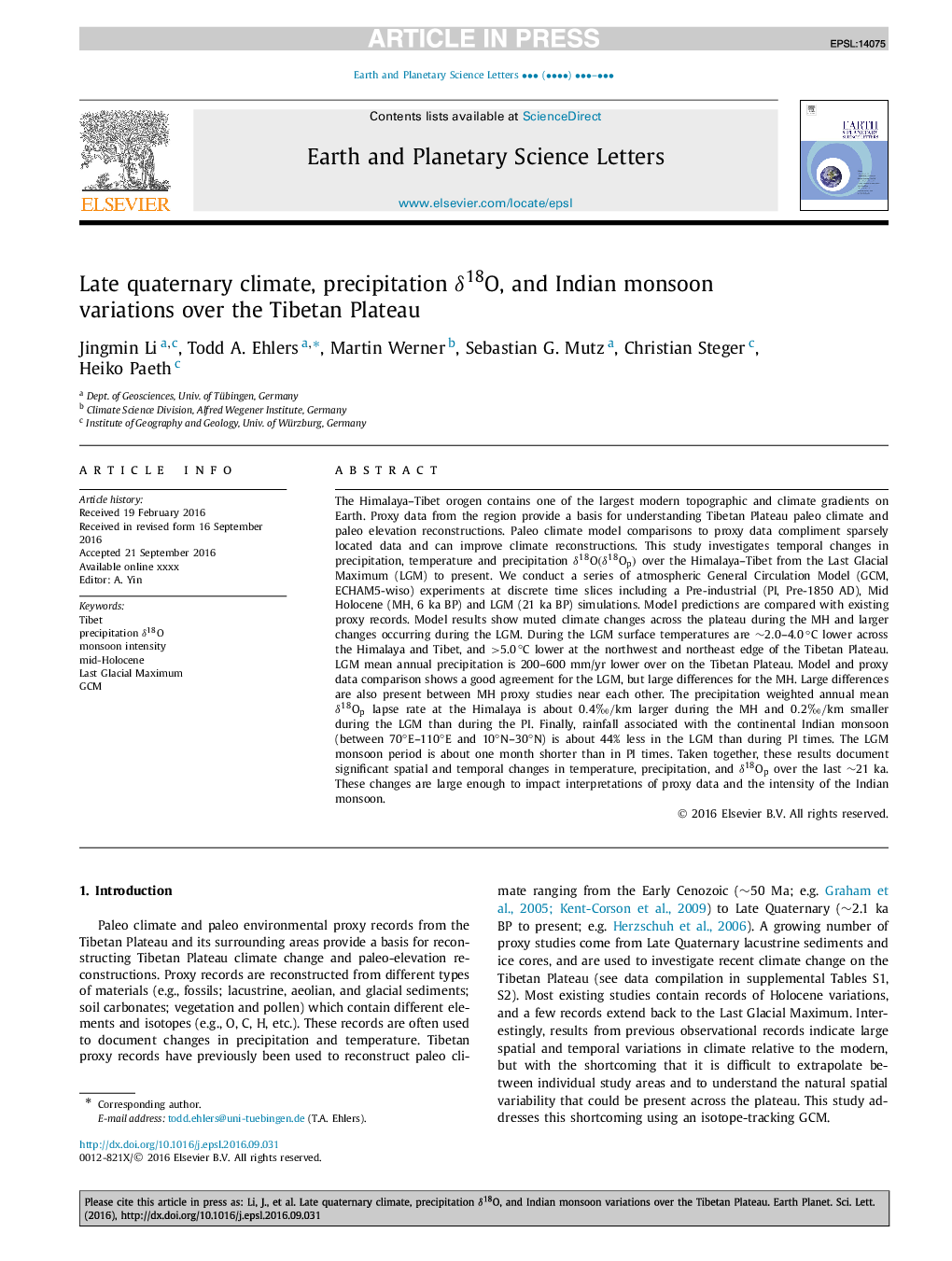| کد مقاله | کد نشریه | سال انتشار | مقاله انگلیسی | نسخه تمام متن |
|---|---|---|---|---|
| 5780080 | 1634699 | 2017 | 11 صفحه PDF | دانلود رایگان |
عنوان انگلیسی مقاله ISI
Late quaternary climate, precipitation δ18O, and Indian monsoon variations over the Tibetan Plateau
دانلود مقاله + سفارش ترجمه
دانلود مقاله ISI انگلیسی
رایگان برای ایرانیان
کلمات کلیدی
موضوعات مرتبط
مهندسی و علوم پایه
علوم زمین و سیارات
علوم زمین و سیاره ای (عمومی)
پیش نمایش صفحه اول مقاله

چکیده انگلیسی
The Himalaya-Tibet orogen contains one of the largest modern topographic and climate gradients on Earth. Proxy data from the region provide a basis for understanding Tibetan Plateau paleo climate and paleo elevation reconstructions. Paleo climate model comparisons to proxy data compliment sparsely located data and can improve climate reconstructions. This study investigates temporal changes in precipitation, temperature and precipitation δO18(δOp18) over the Himalaya-Tibet from the Last Glacial Maximum (LGM) to present. We conduct a series of atmospheric General Circulation Model (GCM, ECHAM5-wiso) experiments at discrete time slices including a Pre-industrial (PI, Pre-1850 AD), Mid Holocene (MH, 6 ka BP) and LGM (21 ka BP) simulations. Model predictions are compared with existing proxy records. Model results show muted climate changes across the plateau during the MH and larger changes occurring during the LGM. During the LGM surface temperatures are â¼2.0-4.0°C lower across the Himalaya and Tibet, and >5.0â°C lower at the northwest and northeast edge of the Tibetan Plateau. LGM mean annual precipitation is 200-600 mm/yr lower over on the Tibetan Plateau. Model and proxy data comparison shows a good agreement for the LGM, but large differences for the MH. Large differences are also present between MH proxy studies near each other. The precipitation weighted annual mean δ18Op lapse rate at the Himalaya is about 0.4â°/km larger during the MH and 0.2â°/km smaller during the LGM than during the PI. Finally, rainfall associated with the continental Indian monsoon (between 70°E-110°E and 10°N-30°N) is about 44% less in the LGM than during PI times. The LGM monsoon period is about one month shorter than in PI times. Taken together, these results document significant spatial and temporal changes in temperature, precipitation, and δ18Op over the last â¼21 ka. These changes are large enough to impact interpretations of proxy data and the intensity of the Indian monsoon.
ناشر
Database: Elsevier - ScienceDirect (ساینس دایرکت)
Journal: Earth and Planetary Science Letters - Volume 457, 1 January 2017, Pages 412-422
Journal: Earth and Planetary Science Letters - Volume 457, 1 January 2017, Pages 412-422
نویسندگان
Jingmin Li, Todd A. Ehlers, Martin Werner, Sebastian G. Mutz, Christian Steger, Heiko Paeth,